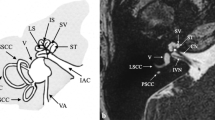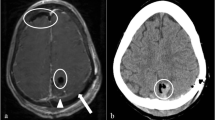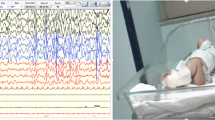Abstract
Schizencephaly is a rare malformation of cortical development resulting from cell migration defects that occur unilaterally or bilaterally. The type of the schizencephalic cleft can be open lip or closed lip. Patients suffering from refractory seizures secondary to schizencephaly should be considered for surgical treatment. In this paper, we retrospectively analyzed two patients with confirmed schizencephaly and intractable seizures. The evaluation methods included a medical history assessment, a neurological examination and magnetic resonance imaging (MRI). Continuous intracranial video-electroencephalogram (vEEG) monitoring with surface electrodes and deep electrodes was evaluated to confirm the epileptogenic zones associated with the schizencephalic lesions. Cortical electrical stimulation was performed to evaluate the neurophysiology of the relevant brain regions. Epileptic focus resection was performed close to the schizencephalic cleft according to the results of intracranial EEG and stimulation while preserving neurological functions. MRI revealed bilateral open lip schizencephaly in one patient and closed lip schizencephaly in the other patient. The epileptogenic zones were localized close to the schizencephalic clefts. The seizure outcome was Engel’s class Ia in both patients at 1-year follow-up. No significant neurological deficits were found, and their activities of daily life were significantly improved. We conclude that abnormal cortex near the schizencephalic clefts may display an extrinsic epileptogenicity. Accurate localization of the epileptogenic zones using intracranial EEG and electrical stimulation can lead to a seizure-free outcome in patients with refractory epilepsy associated with schizencephaly.










Similar content being viewed by others
Abbreviations
- EEG:
-
Electroencephalogram
- vEEG:
-
Video-electroencephalography
- MRI:
-
Magnetic resonance imaging
- ESM:
-
Electric stimulation mapping
- AEDs:
-
Antiepileptic drugs
References
Barkovich AJ, Kjos BO (1992) Schizencephaly: correlation of clinical findings with MR characteristics. AJNR Am J Neuroradiol 13:85–94
Barkovich AJ, Kuzniecky RI, Jackson GD, Guerrini R, Dobyns WB (2001) Classification system for malformations of cortical development: update 2001. Neurology 57:2168–2178
Dies KA, Bodell A, Hisama FM et al (2013) Schizencephaly: association with young maternal age, alcohol use, and lack of prenatal care. J Child Neurol 28:198–203
Denis D, Chateil JF, Brun M et al (2000) Schizencephaly: clinical and imaging features in 30 infantile cases. Brain Dev 22:475–483
Granata T, Freri E, Caccia C, Setola V, Taroni F, Battaglia G (2005) Schizencephaly: clinical spectrum, epilepsy, and pathogenesis. J Child Neurol 20:313–318
Silbergeld DL, Miller JW (1994) Resective surgery for medically intractable epilepsy associated with schizencephaly. J Neurosurg 80:820–825
Packard AM, Miller VS, Delgado MR (1997) Schizencephaly: correlations of clinical and radiologic features. Neurology 48:1427–1434
Engel J Jr, Van Ness PC, Rasmussen TB, Ojemann LM (1993) Outcome with respect to epileptic seizures. In: Engel J Jr (ed) Surgical Treatment of the Epilepsies, 2nd edn. New York, Raven Press
Faiella A, Brunelli S, Granata T et al (1997) A number of schizencephaly patients including 2 brothers are heterozygous for germline mutations in the homeobox gene EMX2. Eur J Hum Genet 5:186–190
Brunelli S, Faiella A, Capra V et al (1996) Germline mutations in the homeobox gene EMX2 in patients with severe schizencephaly. Nat Genet 12:94–96
Merello E, Swanson E, De Marco P et al (2008) No major role for the EMX2 gene in schizencephaly. Am J Med Genet A 146A:1142–1150
Tietjen I, Bodell A, Apse K et al (2007) Comprehensive EMX2 genotyping of a large schizencephaly case series. Am J Med Genet A 143A:1313–1316
Leblanc R, Tampieri D, Robitaille Y, Feindel W, Andermann F (1991) Surgical treatment of intractable epilepsy associated with schizencephaly. Neurosurgery 29:421–429
Diaz RJ, Sherman EM, Hader WJ (2008) Surgical treatment of intractable epilepsy associated with focal cortical dysplasia. Neurosurg Focus 25:E6
Schramm J, Kral T, Blumcke I, Elger CE (2000) Surgery for neocortical temporal and frontal epilepsy. Adv Neurol 84:595–603
Siegel AM, Jobst BC, Thadani VM et al (2001) Medically intractable, localization-related epilepsy with normal MRI: presurgical evaluation and surgical outcome in 43 patients. Epilepsia 42:883–888
Cascino GD (2004) Surgical treatment for extratemporal epilepsy. Curr Treat Options Neurol 6:257–262
Centeno RS, Yacubian EM, Sakamoto AC, Ferraz AF, Junior HC, Cavalheiro S (2006) Pre-surgical evaluation and surgical treatment in children with extratemporal epilepsy. Childs Nerv Syst 22:945–959
Najm I, Ying Z, Babb T et al (2004) Mechanisms of epileptogenicity in cortical dysplasias. Neurology 62:S9–13
Palmini A, Gambardella A, Andermann F et al (1995) Intrinsic epileptogenicity of human dysplastic cortex as suggested by corticography and surgical results. Ann Neurol 37:476–487
Blenkmann A, Seifer G, Princich JP, Consalvo D, Kochen S, Muravchik C (2012) Association between equivalent current dipole source localization and focal cortical dysplasia in epilepsy patients. Epilepsy Res 98:223–231
Krsek P, Maton B, Jayakar P et al (2009) Incomplete resection of focal cortical dysplasia is the main predictor of poor postsurgical outcome. Neurology 72:217–223
Maehara T, Shimizu H, Nakayama H, Oda M, Arai N (1997) Surgical treatment of epilepsy from schizencephaly with fused lips. Surg Neurol 48:507–510
Landy HJ, Ramsay RE, Ajmone-Marsan C et al (1992) Temporal lobectomy for seizures associated with unilateral schizencephaly. Surg Neurol 37:477–481
Morioka T, Nishio S, Hisada K et al (2001) An operated case of medial temporal lobe epilepsy associated with schizencephaly. No To Shinkei 53:293–299
Choi HY, Koh EJ (2013) Long-term outcome of surgical treatment of patients with intractable epilepsy associated with schizencephaly. Acta Neurochir (Wien) 155:1717–1724
Cui Z, Song H, Ling Z, Pan L, Xu B (2013) Resection or multi-lobe disconnection for intractable epilepsy with open-lip schizencephaly. J Clin Neurosci 20:1780–1782
Kim DH, Kwon OY, Jung SW et al (2014) Location of irritative zone in epileptic brains of schizencephalic patients. Clin EEG Neurosci. doi:10.1177/1550059414548859
Author information
Authors and Affiliations
Corresponding author
Ethics declarations
Conflict of interest
The authors have no financial conflicts of interest.
Rights and permissions
About this article
Cite this article
Zhang, J., Yang, Z., Yang, Z. et al. Successful surgery for refractory seizures associated with bilateral schizencephaly: two case reports and literature review. Neurol Sci 37, 1079–1088 (2016). https://doi.org/10.1007/s10072-016-2543-8
Received:
Accepted:
Published:
Issue Date:
DOI: https://doi.org/10.1007/s10072-016-2543-8




